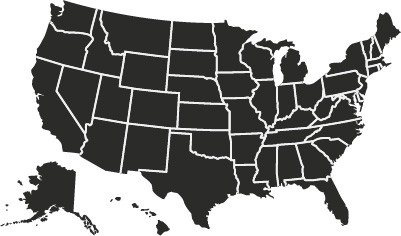The renewable energy industry is booming.
Most recent estimates suggest that roughly 18% of all electricity in the United States comes from a renewable resource. This renewable energy portfolio includes the ever-growing solar energy share from homes and businesses.
On a smaller scale, solar panels have the best financial return on investment over the shortest time period, compared to other renewable generation sources. This is largely driven by state incentives for solar and the federal tax credit available for residential solar in any state. These financial incentives or a tax credit allocation have been passed through the state legislatures to speed up the adoption of solar as a renewable technology.
So, what incentives are you eligible for? We’ll take a look at solar power incentives by state:

- California
- Colorado
- Idaho
- Nevada
- New Mexico
- Texas
- Utah
- Virginia
California Solar Incentives

Perhaps the best state with tax incentives for renewable energy projects, California has set perhaps the most aggressive goal in the United States, seeking to receive 100% of their energy from renewable energy by 2045 with an intermediary goal of 60% of their energy coming from renewables by 2030. Many areas of California will offer rebates for installing solar, ranging anywhere from a flat price of $500 up to $0.95 per watt installed.
This means that if you were to install a 5 kilowatt system, you could receive a rebate for up to $4,750. Additionally, California is one of the net metering states. This allows homeowners to produce more solar than they consume at a given time and export it to the grid. Then, this energy can be credited back to your home at the end of the month, so you still receive the full benefit of it even if you don’t use it right as it is generated.
Colorado Solar Incentives

To bolster solar installation rates, government officials in Colorado have passed various incentives and energy programs. This includes various rebates in the state, ranging from a flat rebate of $400 up to much larger rebates worth $3,000. The amount residents can receive depends largely on which utilities cover their area.
Additionally, there are many tax breaks for installing a solar array in Colorado. Perhaps the most significant is the sales tax exemption. This means that zero sales tax must be paid on solar installations saving home and business owners hundreds and even thousands of dollars switching to solar. Also, because solar raises your property value, property tax exemptions have been put into place to raise these taxes once they make the switch.
Finally, one of the more unique incentives in Colorado is the use of community solar. This type of incentive allows homeowners to buy into the use of a portion of a much larger solar system located miles away from their home.
This allows buyers to invest in expanding solar energy in their state and receiving renewable energy credits on their energy bills. It makes solar energy accessible without having to make a large time and financial investment to install a solar system on their roof.
Idaho Solar Incentives

Idaho is seeking to incentivize homeowners to switch to solar by giving them income tax deductions for solar installations. This income tax deduction is equal to 40% of the total installation cost in the first year, with a maximum deduction of $5,000.
Then, in each of the following 3 years, homeowners can take a deduction equal to 20% of the value. The only stipulation is that the total deduction for the full value of the system cannot exceed $20,000.
Idaho is also a net metering state which makes getting credit for your generation easier than ever.
Nevada Solar Incentives

To help expand solar power, government officials in Nevada have passed net metering laws that allow utilities to set their own net metering standards. NV Energy will credit customers for 95% of the value of the energy cost, while the Valley Electric Association will credit you the full value of the electricity. Finally, NV Energy customers are also eligible for an immediate rebate equal to $0.15 per watt of installed solar. For example, a 5 kilowatt system yields a rebate of $750.
New Mexico Solar Incentives

New Mexico is seeking to increase its solar energy share through the use of some unique programs. This includes a sustainable building tax credit which can get homeowners up to $6.50 per square foot when utilizing solar in a certified sustainable home.
Additionally, solar panel owners in areas served by El Paso Electric Company can receive up to $0.02 per kilowatt-hour generated. Finally, net metering laws and property tax exemptions round out the incentive payments in this southwestern state.
Texas Solar Incentives

Texas is also investing heavily in solar, and it provides an impressive state incentive for its solar program. Energy incentives such as net metering and various local solar power rebates from specific utilities have helped build out hundreds of MWs of solar in the state.
For example, Austin energy customers can receive a $2,500 rebate in addition to being paid a guaranteed $0.097 per kilowatt hour of solar generation. Also, CPS energy customers in Texas are eligible to receive a solar rebate equal to $1.20 per watt. This means that a 5 kilowatt system will yield a rebate of $6,000.
Finally, the solar rights law in this state prevents the Homeowners Association from banning solar on residential homes.
Utah Solar Incentives

Utah has an extremely aggressive solar tax credit allocation. Utah has a policy that will give homeowners and business owners a tax credit equal to 25% of the total installed cost with a maximum credit of $1,600. This means that systems which cost up to $6,400 are fully eligible for the tax credit.
Additionally, Utah is another one of the net metering states. Net metering means that if solar owners produce more solar electric power than they use, they can credit it to their electric utility. Net metering helps reduce green energy costs and contributes to the growth of the solar industry.
Virginia Solar Incentives
Virginia is attempting to persuade homeowners to switch to solar by offering to purchase some of their electricity produced for a premium price in places served by the Tennessee Valley Authority. This allows the payback period to be shortened for all solar installations. In addition to this direct financial incentive, Virginia also offers a net metering program and residential property tax exemption to further incentivize the switch.
In addition to all of these state incentives for solar, there are also federal tax incentives for solar. The most widely used incentive program is the federal solar investment tax credit (ITC). By filling out Form 5695, homeowners and business owners receive a tax credit on their following year’s taxes equal to 30% of the total installed value.
So, if a 5 kilowatt system costs a homeowner $15,000 in all, they would then be eligible for a tax credit equal to $4,500. This means their total cost is now only $10,500 even before applying any state tax incentives.
Homeowners can also benefit from a power purchase agreement (PPA). PPAs help solar customers enter into an agreement with solar manufacturers that makes solar power more affordable.
Many states also include an energy efficiency guide. This energy efficiency guide provides additional rebates and incentives to pair solar with energy-efficient appliances and lighting. By combining both federal, state, and local solar tax incentives plus the already record low cost of solar, installing a system to begin receiving clean and renewable energy is more affordable than ever before.
